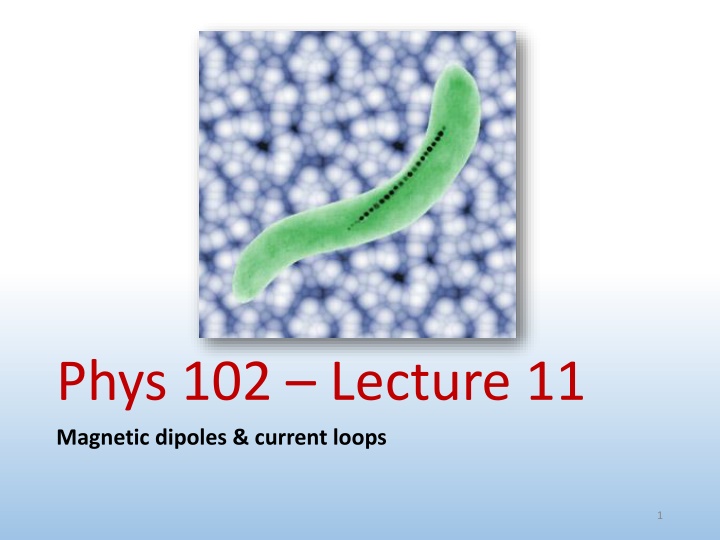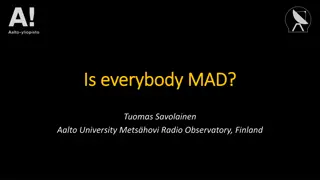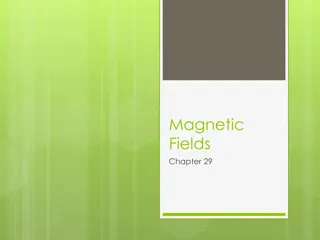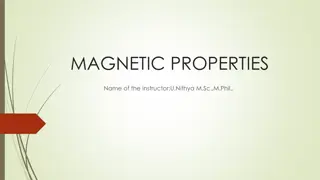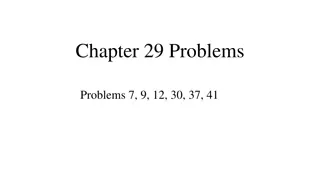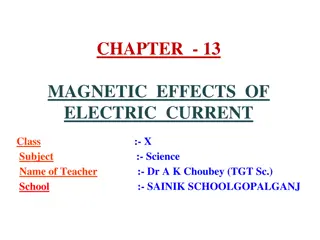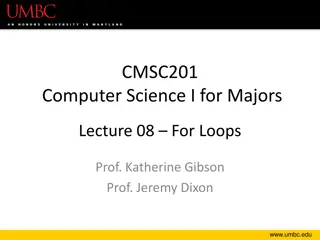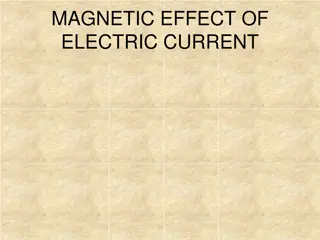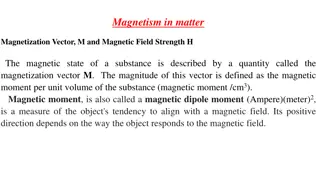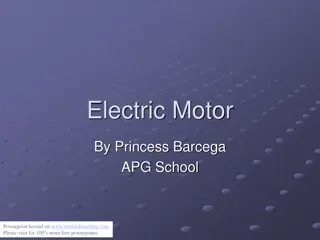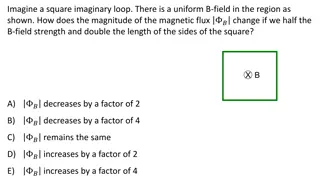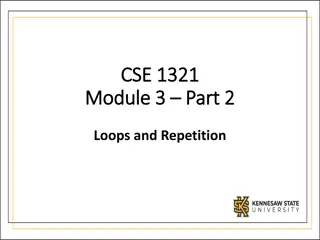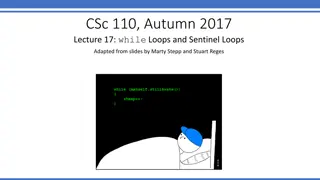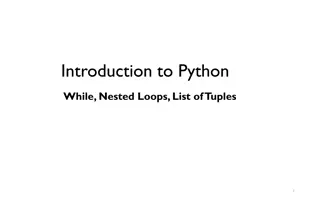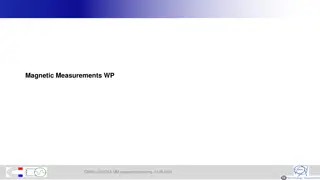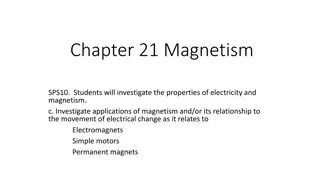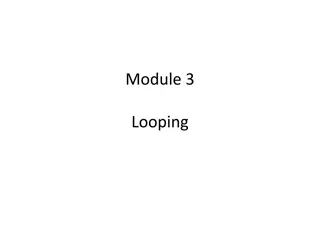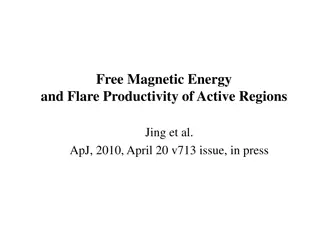Magnetic Dipoles and Current Loops: Understanding Concepts
Magnetism is explored through magnetic dipoles and current loops in this lecture. Topics covered include magnetic dipole moments, alignment in fields, potential energy configurations, magnetotactic bacteria, NMR/MRI principles, and more. The interaction of magnetic fields with dipoles and currents is demonstrated, helping in understanding the fundamentals of magnetism.
Download Presentation

Please find below an Image/Link to download the presentation.
The content on the website is provided AS IS for your information and personal use only. It may not be sold, licensed, or shared on other websites without obtaining consent from the author.If you encounter any issues during the download, it is possible that the publisher has removed the file from their server.
You are allowed to download the files provided on this website for personal or commercial use, subject to the condition that they are used lawfully. All files are the property of their respective owners.
The content on the website is provided AS IS for your information and personal use only. It may not be sold, licensed, or shared on other websites without obtaining consent from the author.
E N D
Presentation Transcript
Phys 102 Lecture 11 Magnetic dipoles & current loops 1
Today we will... Learn how magnetic fields act on Magnetic dipoles Current loops Apply these concepts! Magnetotactic bacteria Principles behind NMR/MRI, EPR/ESR Magnetic materials (paramagnets and ferromagnets) Phys. 102, Lecture 11, Slide 2
Magnetic dipole & dipole moment A magnetic N and S pole make up a magnetic dipole Magnetic dipole Recall: electric dipole N +q p = = q S Magnetic dipole moment is analogous to electric dipole moment Vector from S to N pole (by convention) Phys. 102, Lecture 11, Slide 3
Dipole in uniform field Electric & magnetic dipole moments align parallel to field = = sin B = sin pE = Torque: Lect. 3 cos cos U U pE B Lect. 4 Energy: dip dip B E DEMO Phys. 102, Lecture 11, Slide 4
ACT: CheckPoint 1.1 Which of the three configurations of magnetic dipoles shown below has the highest potential energy? C. A. B. N N S N N S S N S S N S Phys. 102, Lecture 11, Slide 5
Calculation: magnetic bacteria Magnetotactic bacteria grow a chain of magnets to align to the Earth s B field Room temperature kinetic energy tends to randomizes orientation 21 4 10 = K J . dip + + 0 K U Dipoles are randomized . . dip dip Magnetospirillum magnetotacticum 0 K U Dipoles tend to be aligned . . dip dip Find minimum value of such that cells align to the Earth s field Phys. 102, Lecture 11, Slide 6
Spin & magnetic fields Electrons, protons, & neutrons (and many others) have an intrinsic property called spin which gives them a magnetic dipole moment B Nuclear magnetic resonance (NMR) / magnetic resonance imaging (MRI) + + Detects energy difference between nuclear spins (ex: 1H) parallel and anti-parallel to B field = + 26 = 1.4 10 J/T prot = U U B B dip prot dip prot Electron paramagnetic resonance (EPR) / electron spin resonance (ESR) applies same principle with electron spin 24 = 9.3 10 J/T elec Phys. 102, Lecture 11, Slide 7
Magnetic force on current Recall: B field exerts a force on a moving charge q Current I is flow of + charge = = sin F q vB sin ILB Angle between I and B Current B field strength Length of wire Right-hand rule (RHR) Thumb along I Fingers along F on I is out of palm B L I B F Phys. 102, Lecture 11, Slide 8
CheckPoint 2.1 A rectangular loop of wire is carrying current I as shown. There is a uniform magnetic field parallel to the sides a b and c d. d c B I a b What is the direction of the force on section a b of the wire? A. force is zero B. out of the page C. into the page ...on section c d of the wire? Phys. 102, Lecture 11, Slide 9
ACT: CheckPoint 2.2 A rectangular loop of wire is carrying current I as shown. There is a uniform magnetic field parallel to the sides a b and c d. d c B I a b What is the direction of the force on section b c of the wire? A. force is zero B. out of the page C. into the page Phys. 102, Lecture 11, Slide 10
ACT: Force on loop A rectangular loop of wire is carrying current I as shown. There is a uniform magnetic field parallel to the sides a b and c d. d c B I b a What is the direction of the force on section d a of the wire? A. force is zero B. out of the page C. into the page Phys. 102, Lecture 11, Slide 11
CheckPoints 2.3 & 2.4 So, does the loop move? Compare magnitudes of forces: d c B w I b a DEMO Phys. 102, Lecture 11, Slide 12
Torque on current loop F Loop spins in B field a d c B B w L b a L b Side view Top view F B field generates a torque on the loop = sin IAB = = sin IBwL sin FL loop loop Loop area Phys. 102, Lecture 11, Slide 13
Electric motors DC motors use a clever arrangement of current carrying coils and permanent magnets to turn a shaft: DEMO Phys. 102, Lecture 11, Slide 14
Current loop & magnetic dipole B field exerts torque on loop a d c normal normal B B b a b Side view Top view = = sin B sin IAB loop Current loop behaves the same as magnetic dipole to loop plane Convenient to define a normal vector to loop plane, || to dipole moment Torque aligns normal vector|| to B field Phys. 102, Lecture 11, Slide 15
Magnetic dipole & current loop A current loop behaves the same as a magnetic dipole N = = A I S I Equivalent magnetic dipole moment: = NIA True for flat loop of any shape For a loop with N turns of wire Curl fingers along I along thumb Another right hand rule : Phys. 102, Lecture 11, Slide 16
ACT: Current loop practice A loop is placed in a uniform B field. A current I flows around the loop as shown. I B Which way does loop rotate? A. Clockwise B. Counterclockwise C. The loop does not rotate Phys. 102, Lecture 11, Slide 17
ACT: Torque on a loop Compare the torque on loop 1 and 2, which have identical area A, and current I. B B A. 1 > 2 B. 1 = 2 C. 1 < 2 Phys. 102, Lecture 11, Slide 18
Para- & ferromagnetism In some materials, unpaired electron (spin & orbit) give atoms net magnetic moment In paramagnets, atomic dipoles are randomly oriented In ferromagnets, atomic dipoles interact and align together B Apply a B field and dipoles align! Material now behaves as a magnet Material is a permanent magnet Phys. 102, Lecture 11, Slide 19
ACT: Magnetic materials The N pole of a permanent magnet is brought near a paramagnetic ball bearing. What happens next? A. The ball moves toward the magnet B. The ball moves away from the magnet C. The ball does not move DEMO Phys. 102, Lecture 11, Slide 20
Summary of todays lecture B fields exert torque on magnetic dipoles sin dip B = = cos U B dip B fields exert force on current-carrying wire sin wire F ILB = Current loops are equivalent to magnetic dipole NIA = N A = = N S I Phys. 102, Lecture 11, Slide 21
